I don’t understand why most people in the supply chain business really find this subject of plastic pallet weight capacity so difficult to understand.
For a fact, it is not your responsibility to determine the exact load capacity of pallets. As manufacturers, our work is to design and test the pallets to ensure they meet certain loading criteria.
We do a wide range of tasks such as:
- Designing the plastic pallets
- Choosing appropriate materials (either virgin or recycled HDPE and PP)
- Adopting a suitable manufacturing process (thermoforming, blow molding or injection molding)
- State the required load capacities of the pallets
It is now your duty as the supply chain business owner to comply with the weight limits we have stipulated.
Here is an example of our plastic pallet. Clearly, you can see we have indicated the required plastic pallet load capacity in all possible scenarios.
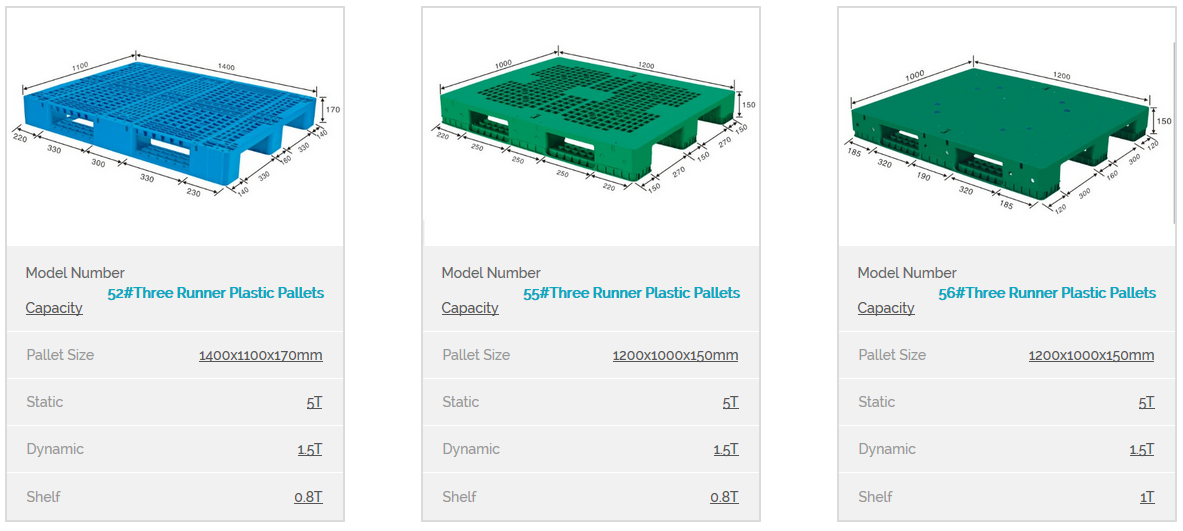
Different types of plastic pallet designs showing static, dynamic and shelf loading capacities.
Why do you still find it difficult to comply?
Honestly, if you don’t follow such simple instructions, then expect to invest in new plastic pallets very soon. Overloading plastic pallets reduces their service lifespan by nearly 43%.
Today, I want to focus on a small area, yet very critical in this industry – understanding plastic pallets load/weight capacity.
By the end of this article, you’ll know the various things you should avoid to increase the service lifespan of your pallets.
Let’s go straight to the main subject of this article:
Factors that Determine Plastic Pallet Weight Capacity
There are a number of factors that will determine the plastic pallet load capacity. Some of these critical aspects include:
1. Type of Plastic Pallet Material
This is the first critical aspect that will determine the amount of weight a plastic pallet can carry. Besides, it forms important classification criteria for plastic pallets.
For example, you will find export plastic pallets, drum plastic pallets, hygienic plastic pallets or heavy duty plastic pallets, just to mention a few.
You can learn more about the classification of plastic pallets in this blog: 12 Types of Industrial Plastic Pallets for Supply Chain Management.
So to start with, I will compare:
- Recycled vs. Virgin Plastic Materials for Pallets
Generally, plastic pallets of the same structural design made from virgin plastic material are more durable that those made from recycled plastic material. This implies the virgin plastic will hold more weight.
Here is a comprehensive comparison between the two:
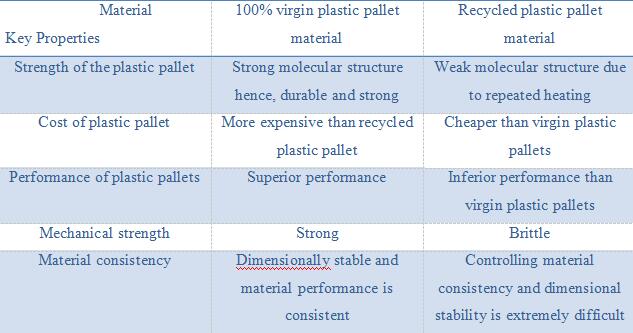
Recycled vs. virgin plastic pallets.
In short, for high load capacities, go for plastic pallets that are made from virgin plastic materials. However, if you go for recycled plastic, they will not last for a long.
- Type of Plastic Pallet Material
Broadly, we use Polypropylene (PP) or High-density polyethylene (HDPE). In most cases, virgin HDPE plastic pallets are most common due to their reasonable price and good load capacity.
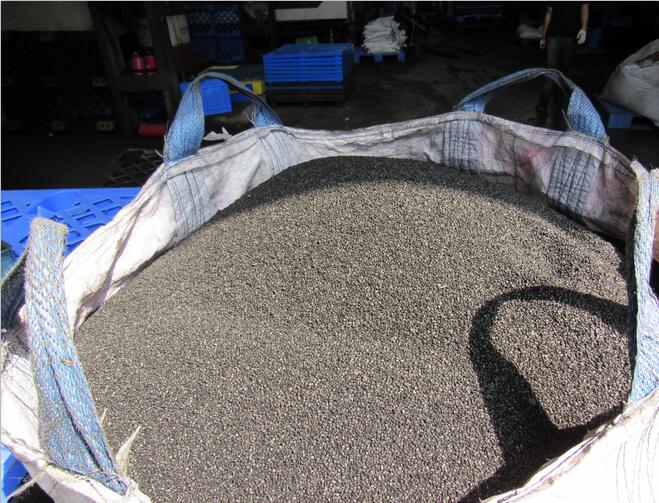
Raw material for making plastic pallet
However, when it comes to the very high load capacity, then PP plastic pallets are a better alternative.
This implies, when you subject HDPE plastic pallets to extremely high load capacity, there is a chance that they’ll wear faster.
In short, the type and nature of material greatly affect the plastic pallet weight capacity. Again, anytime you’re planning to carry very heavy loads, be ready to pay more for the pallet.
2. The Working Environment
Do you know one of the main benefits of plastic pallets is their ability to withstand harsh environmental conditions? For instance, PP and HDPE materials are resistant to most organic and inorganic chemicals.
Maybe you need to read my previous blog on advantages of plastic pallets, you will learn a lot about this subject. Here it is: 13 Plastic Pallet Advantages That Will Save Your Supply Chain Cost Right Away.
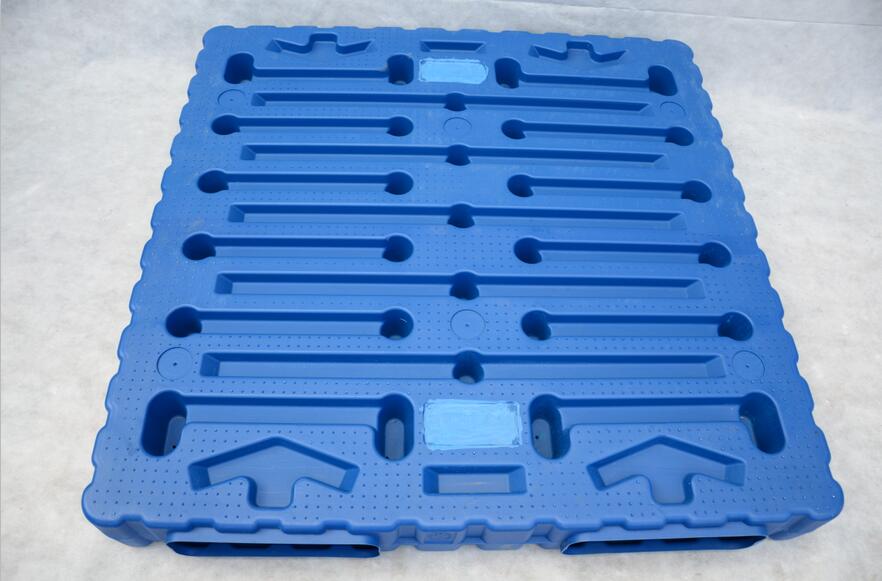
A blow molded plastic pallet.
Still, there are certain limitations that determine the safe working conditions of plastic pallets.
As a leading plastic pallet manufacturer, we do specify the various conditions under which this accessory will serve you optimally.
Normally, extreme temperatures will affect the performance and loading capacity of plastic pallets. That is, the plastic pallet may not support the specified amount of load.
Again, there are certain chemicals that may degrade plastic pallet material. As a result, the plastic pallet weight capacity will reduce significantly.
Basically, you need to consider the variables or specific conditions you intend to use the plastic pallets. This is quite important when you want custom plastic pallets.
3. Specific Applications of Plastic Pallets
We specify plastic pallet load capacity depending on the type of application. By specifying the nature of application, we can determine plastic pallet capacities that guarantee suitable safety standards.
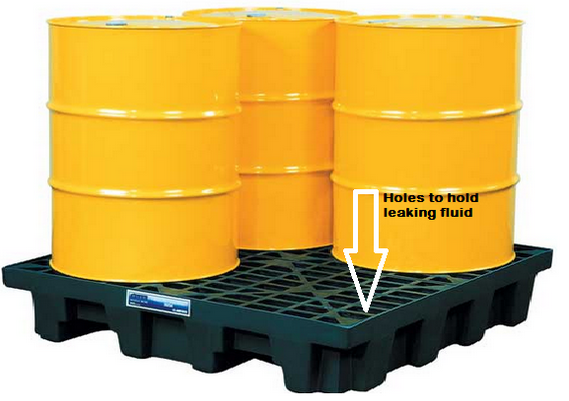
These are spill control plastic pallets with drums.
Typically, at WeePallet, we recommend plastic pallet weight specifications should be slightly be higher than the actual load. This will reduce possible safety issues and concerns, hence reducing the chances of damaging either the pallet or products.
In short, these are some of the most common parameters that will determine the ultimate plastic pallet weight capacity. Others include plastic pallet manufacturing process and design.
Always feel free to discuss all your concerns about plastic pallet weight capacity and we’ll advise you accordingly.
With all these in mind, let’s move to another critical subject:
Types of Plastic Pallet Weight Capacities
In plastic pallet manufacturing process, we always refer to 3 types of plastic pallet load capacities:
- Dynamic load capacity
- Static load capacity
- Racking load capacity
Let’s look at these elements in details.
1. Dynamic Load Capacity of Plastic Pallets
A dynamic load capacity is the amount of weight a plastic pallet can carry when lifted by either a hand jack or forklift.
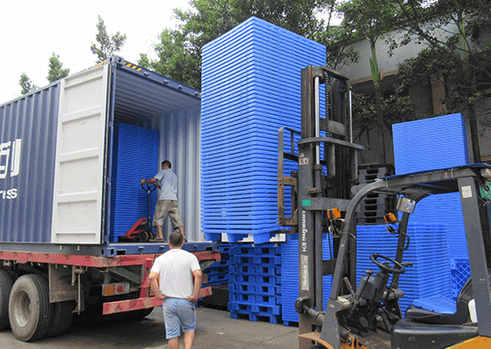
Plastic pallets on a forklift being loaded in a lorry.
In most cases, we use plastic pallets to enable us carry loads from say point “A” to “B”. As a rule of thumb, the actual load you want to carry must not exceed a plastic pallet weight capacity.
Again, even though the term dynamic denotes “activity”, it does not refer to a situation where the plastic pallet is on a conveyor belt.
2. Static Load Capacity of Plastic Pallets
Basically, the static load capacity of plastic pallets is the maximum loads a plastic pallet can hold when in an immobile position/fixed position. That is, it could be on a floor or the pallets stacked together.
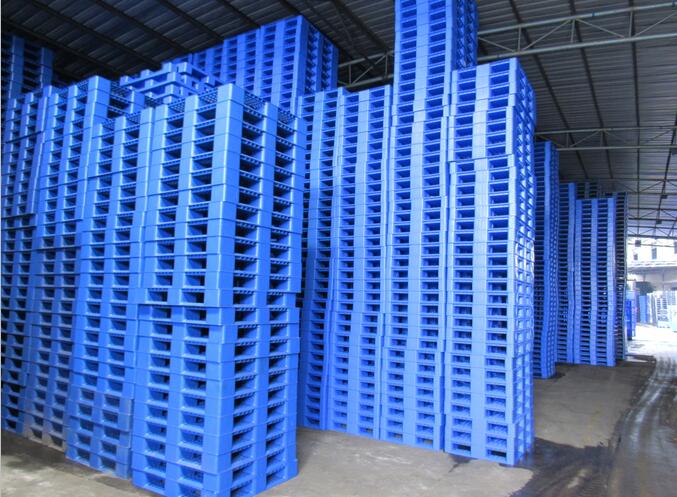
Plastic pallets stacked together in a warehouse.
You’ll find that the static load capacity of plastic pallets is always higher than the dynamic load capacity. Again, in case you have to stack the pallets together, ensure the pallet at the bottom is not subjected to a weight that exceeds the recommended static load rating.
3. Racking Load Capacity of Plastic Pallets
This is the maximum amount of weight a plastic pallet can carry without any supporting structure under it or at the center (on a racking system).
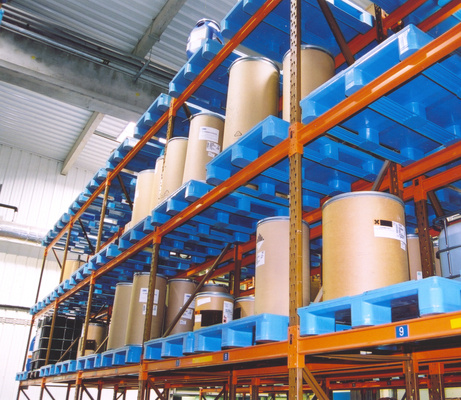
Plastic pallets on a racking system in a warehouse.
Also, as a rule of thumb, the actual load should be lower than the recommended racking load capacity. This is because this load may vary depending on the racking system in place.
Well, at times, determining the specific plastic pallet weight capacity can be a challenging task. This is why you need to consider certain conditions to ensure you get the correct load tests results.
For instance, some of the key factors you need to consider during this process include:
- Load capacity of a pallet is calculated based on the assumption that the weight is evenly distributed on the surface. However, this is not always the case and it is the reason why I insist that the actual weight of the load must be lower than the exact specifications.
- The load does not move on the plastic pallet during transportation. This will cause uneven distribution of load.
What I am trying to say is that, you must be careful whenever you’re dealing with point loads. Such loads can exert a lot of force on specific points thereby causing damage.
Remember, by following the recommended plastic pallet loading criteria, you’ll avoid:
- Possible accidents to the employees
- Reduce cost of damages to the product.
Conclusion
As I said earlier at the beginning of this article, you have no choice but to adhere to the correct loading procedures. Never put a load that exceeds the recommended limits.
By exceeding the recommended plastic pallet weight capacity, you’ll be destroying the pallet hence, reducing their service lifespan.
For questions or inquiries about plastic pallets, feel free to contact us.
Further Reading
- Load Carrying Capacity of Plastic Pallets – By Laszlo Horvath
- Pallet Safety – By Health Safety Excutive
- What is Plastic Pallet –Source: WeePallet Blog
- Pallets for Material Handling – Source: ISO

 86-137-1715-1153
86-137-1715-1153